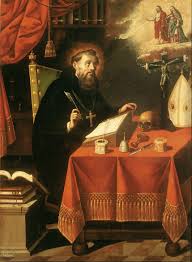with the Holy Pope Francis winning over the World with his Humility and having Americans In tears with his Historic Speech to Congress, we thought of exploring how God changed some of the worst sinners into saints…
Playboys and seductresses
One of the most illustrious saints of the Catholic Church, the fourth-century scholar Augustine of Hippo, is well-known for saying, “God, grant me chastity and continence, but not yet.”
The wealthy Augustine was a playboy of sorts, having not one, but two mistresses. He ran around for years before having a change of heart at age 31. After that, he ditched his mistresses to become engaged, though he ended up breaking off that commitment as well. He instead spent the rest of his life celibate, while teaching and spreading the Christian message.
But Augustine’s escapades are no match for Saint Mary of Egypt, who also lived during the fourth century. According to lore, the young girl ran away from home at age 12 and spent more than a dozen years living on the street as a seductress.
“Nothing made her happier than corrupting innocent young Christian men, She once joined a pilgrimage to Rome and seduced not only the entire crew on the ship, but she seduced all the pilgrims as well.”
After years of exuberant sinning, Saint Mary of Egypt changed her ways. She had gone to Jerusalem looking for young Christians to seduce at church. But when she reached the doors of a church, she felt a strange force repulsing her, and immediately felt the wickedness of her life, repented, prayed to the Virgin Mary and took communion. After hearing a voice tell her to cross the Jordan River, she spent 47 years living in isolation in the desert, surviving mostly off herbs, according to the accounts of a sixth-century patriarch, Saint Sophronius.
Mary and Augustine aren’t alone. The communion of the saints includes Saint Callixtus, who was an embezzler before turning his life around and becoming the bishop of Rome in 218,Saint Camillus de Lellis, a 15th-century Italian priest who founded one of the first health care organizations for the needy, started out as a cardsharp, con man and mercenary,
“He was not somebody you would want to hang out with,”
Just -in-time-Saints
Some saints spend years cultivating virtue and holiness so that they can be assured entrance to heaven. But a few saints are the ultimate procrastinators, sneaking in repentance just under the wire.
The most famous of these last-minute penitence-seekers is Saint Dismas, the thief who supposedly died on the cross alongside Jesus. Legend has it that Saint Dismas repented only minutes before his death, gaining him entrance to heaven.
 In more recent times, Jacques Fesch, a French playboy, bank robber and murderer, had a fervent change of heart while in prison awaiting the guillotine in 1957. The dissolute and wicked man had fathered two children and abandoned both, then planned a bank heist when his parents refused to foot the bill for a yacht to sail to Tahiti. He shot and killed a police officer in his escape from the heist, and his complete lack of contrition (and general obnoxiousness) spurred the judge to sentence Fresch to death.
In more recent times, Jacques Fesch, a French playboy, bank robber and murderer, had a fervent change of heart while in prison awaiting the guillotine in 1957. The dissolute and wicked man had fathered two children and abandoned both, then planned a bank heist when his parents refused to foot the bill for a yacht to sail to Tahiti. He shot and killed a police officer in his escape from the heist, and his complete lack of contrition (and general obnoxiousness) spurred the judge to sentence Fresch to death.
Even in prison, he spent his first months utterly unapologetic, until he had a powerful conversion experience and began to repent his actions, When he was guillotined, his last words were “Holy Mother Mary, have mercy on me,”
Though Fesch hasn’t been officially canonized, a French Cardinal did recommend the man for sainthood, Craughwell said.
Fanatic devotion
The third century was a strange time for Christian devotion in the Middle East, particularly Egypt, Monks would spend decades in the desert, where they lived off leaves and herbs, and slept on boards or inside tombs.
“They were incredibly extreme in their penances,It was just unhealthy, possibly even psychotic.”
For instance, Saint Simeon Stylites was one of the most famous pillar-hermits — he lived on top of a pillar for years. (Yes, there were multiple pillar-hermits.) The former shepherd boy, who was born in 338 near modern-day Syria, became a monk at 16. He focused on such outlandish and extreme penances that his brethren thought him ill-suited to live in the community, according to the Catholic Encyclopedia.
He allegedly fasted from all food or water for the 40 days of Lent, and then upped the ante by doing so while standing upright as long as possible. When news of his extreme devotion spread, pilgrims came to him in the desert seeking advice. To avoid this nuisance and better focus on his prayers, he had a small pillar built and stayed atop it for decades, conversing with people only if they climbed a small ladder perched near his pillar. Over the years, the pillar grew from 9 feet (2.7 meters) to 50 feet (12.7 m) in height, according to the Catholic Encyclopedia.
Many of the most revered and honored saints, such as Teresa of Avila, also spent years depriving themselves of food and water. For instance, Teresa would use twigs and olive branches to make herself vomit — which nowadays would be classified as bulimia, according a 2001 study in the Journal of Criminal Justice and Popular Culture.
On days when she took communion, Saint Catherine of Siena would go to her study and vomit up any food that she ate, according to the study. In fact, according to the book “Holy Anorexia” (University of Chicago Press, 1954), fully half of the medieval saints showed symptoms of anorexia.
How do you Become a Saint ?
Though many dubious saints were raised up to exalted status by popular claim and rumor, they were essentially grandfathered into their positions. Nowadays, it’s much tougher to make it onto the holy dream team.
After a priest who “got shanked in a barroom brawl” in the 10th century gained popular support as a saint in Scandinavia, the church decided to take control of the process, Craughwell said.
Nowadays, every detail of a potential saint’s life is scrutinized, and candidates for sainthood must be credited with two documented miracles to earn the official title.


























Comments